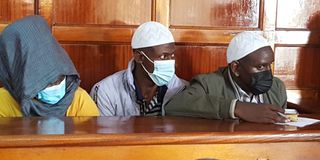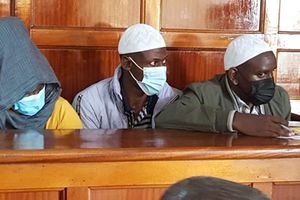
Terror convicts (from left) Lydia Nyawira Mburu, Mohamed Osman Nane and Abdimajit Hassan Adan.
Two terrorists convicted this week for plotting attacks in Nairobi had links to one of the gunmen who raided DusitD2 hotel complex in 2019, killing 21 people, the Nation can reveal.
Abdimajit Hassan Adan and Mohammed Osman Nane, who were this week jailed for 25 years for plotting attacks on key installations in Nairobi, were in contact with Omar Abdi Siyat aka Samatra prior to their arrest in 2018.
The two will however serve 19 years in Kamiti Maximum Prison after six years were commuted. They were imprisoned alongside Lydia Nyawira, who was handed a three-year jail term for forging an Identification Card.
Abdimajit and Nane were arrested in 2018 in Isiolo with explosives and AK 47 rifles after police intercepted them on their way to Nairobi.
Abdimajit, who was the first accused, had received four photos which they were to use to falsify Kenyan Identity cards to conceal their identity.
One of the photos was that of Omar Abdi Siyat aka Samatra.
Abdi was one of the gunmen who arrived at the entrance of the Dusit D2 hotel complex and started shooting indiscriminately on January 16, 2019.
The other gunmen were Ali Salim Gichunge, Osman Ibrahim Gedi alias Abdiweli Gedi, Mahir Riziki and another fighter only identified as Hassan.
Born in 1992 in Dagahaley, one of the Dadaab refugee camps, Abdi had activated a new Kenyan phone on January 4 2019 in preparation for the attack and travelled to Nairobi from Dagahaley the next day.
The phone immediately placed a call to Somalia after its activation, and Abdi continued to contact numbers in Somalia until January 14 2019, when the phone was last used, according to intelligence reports.
On 13 January 2019, Abdi moved to the Gichunges’ safe house on the outskirts of Nairobi, where he stayed until the attack. On the day of the attack, CCTV footage captured Gichunge and Abdi entering the DusitD2 complex in black gear and armed with assault rifles.
Riziki was the suicide bomber who blew himself up outside Secret Garden restaurant.
Al Shabaab dubbed the Dusit D2 operation Al-Qudsu Lan Tuhawwad (“Jerusalem will never be Judaized”) and stated that it had targeted “Western and Zionist interests worldwide.”
One of the other three photos was used in making an ID which belonged to Mbarak Abdi Huka, who was on February 15, 2018 killed in Merti, Isiolo County.
He was killed when an elite team of Kenyan security agencies ambushed them as they headed to Nairobi while driving in a motor vehicle fitted with Improvised Exclusive Devices (IEDs).
The other two photos belonged to two people who remain unknown to date. They were to be used by two militants only identified as Ahmed and Said. The two fled during the shootout with Kenyan security forces in Isiolo.
According to security expert Haggai Chogo, the faking of identities by these militants is just a usual way criminals use to survive.
Chogo explained this is aimed at camouflaging so as they can confuse investigators or divert attention from what their real plan is.
“The actions of terrorists are usually advanced, they usually have a mission and motive all guided by a certain timeline,” he said.
According to him, there is a need for investigating officers to do more scrutiny once they arrest such people.
This, he said, can only be achieved by ensuring thorough forensic analysis.
Security analyst Mr George Musamali also says the disguised identity is part of a scheme to conceal detection.
“They are only being tactical and each time they are trying to use a way they can to divert attention,” he says.
In an article published by Ms Suzanne Barber, who is an American engineer and author, fake IDs are an important tool for terrorists.
She says that the ability of terrorists to steal or falsify identities is a major weakness in counter-terrorism efforts.
“We need to make it harder for terrorists to falsify their identities, and prevent them from acquiring valuable identity documents,” she writes.









